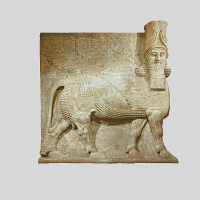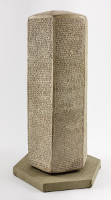Highlights from the Collection: Assyria
From 1928-1935, the Oriental Institute conducted excavations at the site of Khorsabad in northern Iraq. Called Dur-Sharrukin ("Fortress of Sargon") in ancient times, this capital city was built by the Neo- Assyrian king Sargon II (ca. 721-705 B.C.) and abandoned shortly after his death. The bulk of the museum's Assyrian collection comes from those excavations and is best known for the colossal human-headed winged bull and the carved stone reliefs that lined the principal rooms of the palace.
Human-Headed Winged Bull
This colossal sculpture was one of a pair that guarded the entrance to the throne room of King Sargon II. A protective spirit known as a "lamassu", it is shown as a composite being with the head of a human, the body and ears of a bull, and the wings of a bird. Viewed from the side, the creature appears to be walking; but when viewed from the front, it appears to be standing still. Thus it is actually represented with five, rather than four, legs.
Assyrian Soldiers Towing a Boat
Archaeologists from the Oriental Institute discovered this relief fragment in the debris of the throne room of King Sargon II. The fragment shows naked Assyrian soldiers towing a boat through a shallow river, perhaps during one of Sargon's campaigns against Marduk-apla-iddina II, king of Babylon, whose name is inscribed in the text above the scene. According to the Biblical account, that same Babylonian king (referred to as Merodach Baladan) sent envoys with presents to Hezekiah, king of Judah, upon his recovery from illness (cf. II Kings 20; Isaiah 39).
Two Assyrian Officials
 This relief comes from a wall just outside the throne room of Sargon II's palace. Two court officials - who are beardless and, therefore, possibly identifiable as eunuchs - are shown marching toward the king. The second figure motions to the line of men that stood behind him to come forward toward the king. He stands with his back toward the viewer, as can be seen by the position of his hands and garment, which covers his left shoulder. Traces of the paint originally used for coloring the sculpture still remain on portions of the relief.
This relief comes from a wall just outside the throne room of Sargon II's palace. Two court officials - who are beardless and, therefore, possibly identifiable as eunuchs - are shown marching toward the king. The second figure motions to the line of men that stood behind him to come forward toward the king. He stands with his back toward the viewer, as can be seen by the position of his hands and garment, which covers his left shoulder. Traces of the paint originally used for coloring the sculpture still remain on portions of the relief.
The ankle-length robes of the attendants are ornamented with squares and trimmed with fringe and beads along the lower edges. A diagonal band of red crosses the chest. Each courtier wears wire bracelets, earrings, and sandals which are held in position with toe- thongs and straps.
This relief stands about eleven feet high and weighs approximately two and a half tons.
Deity Holding a Flowing Vase
These two statues once flanked a doorway leading into the temple of Nabu, the god of writing and of knowledge. Nearly identical sculptures were found at the entrances to other temples at Dur-Sharrukin. As well as representing minor deities, the figure also may have served as supports for as-yet-unidentified objects, as there are saucer-like hollows cut into the square blocks resting on their crowns.
Each of these gods holds a small vessel from which flow four streams of water - two rise over his shoulders to flow down his back and two stream down the front of his garment to his feet. Figures of this type are common in the art of the ancient Near East; they probably represent fertility deities who are embodiments of the life-giving and life-sustaining forces within fresh water.
The statues, when found, were in many pieces. These fragments were cleaned, soaked in a hardening solution, and then reassembled and restored by a member of the technical staff of the Oriental Institute.
Bronze Band
 The fortress of Sargon II at Khorsabad included a complex of temples, one of which was devoted to the sun god Shamash. This bronze band encircled one of a pair of cedar poles-possibly supports for divine emblems-that once flanked the doorway to this temple. The band was affixed to the pole by nails driven through the centers of the rosettes that decorate the three narrow bands framing the two main registers.
The fortress of Sargon II at Khorsabad included a complex of temples, one of which was devoted to the sun god Shamash. This bronze band encircled one of a pair of cedar poles-possibly supports for divine emblems-that once flanked the doorway to this temple. The band was affixed to the pole by nails driven through the centers of the rosettes that decorate the three narrow bands framing the two main registers.
In the upper register, Sargon is shown grasping two massive bulls by the horns. This ancient motif, known as "the master of animals," was well established in Mesopotamian royal iconography and perhaps symbolized the dominance, vitality, and potency of the reigning monarch. To the left of the king and bulls is a large bird depicted in flight, to the right, facing the king and bulls, is an attendant wearing a kilt. In the lower register, only a fig tree and the tip of a plough are preserved.
King Ashurnasirpal II
Room G in Ashurnasirpal II's palace may have served as the setting for a ritual by which weapons were purified. The walls of this chamber were adorned with exceptionally well-carved and minutely detailed reliefs showing the king standing between, alternately, two courtiers and two winged genies. This fragment shows the king himself, identifiable by his fez-shaped cap surmounted by a conical spike. Originally, this piece formed part of a scene. The king, grasping a bow, stood ready to pour a libation from a cup poised delicately on the tips of his fingers. Facing him was an attendant who carried a fly-whisk with which to banish insects from the royal presence.
Clay Prism of Sennacherib
On the six inscribed sides of this clay prism, King Sennacherib recorded eight military campaigns undertaken against various peoples who refused to submit to Assyrian domination. In all instances, he claims to have been victorious. As part of the third campaign, he beseiged Jerusalem and imposed heavy tribute on Hezekiah, King of Judah-a story also related in the Bible, where Sennacherib is said to have been defeated by "the angel of the Lord," who slew 185,000 Assyrian soldiers (II Kings 18-19).






